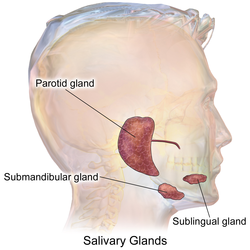EXOCRINE GLAND:
Exocrine
glands are glands whose secretions pass into a system of ducts that
lead ultimately to the exterior of the body. So the inner surface of the
glands and the ducts that drain them are topologically continuous with
the exterior of the body (the skin). Endocrine glands, in contrast,
place their secretions into the internal environment - the blood.
Examples of exocrine glands are:
Salivary
glands that secrete saliva into the mouth bile-producing glands of the
liver prostate gland the portion of the pancreas that secretes
pancreatic fluid into the duodenum. (The pancreas is also an endocrine
gland - its islets of Langerhans secrete several hormones into the
blood.) gastric glands and sweat glands
TYPES:Gastric Glands
 They are located in different regions of the stomach.
They are located in different regions of the stomach.Salivary Glands
It produce saliva.
Saliva formed of several things including amylase, a digestive enzyme that breaks down starch into maltose and glucose.
Sweat Glands
It produces sweat. It produce and secrete substances onto an epithelial surface by way of a duct.
There are three different ways in which exocrine glands secrete their products:
Merocrines glands (e.g., salivary glands) secrete their product from intact cells.
Apocrine glands (e.g., mammary glands) accumulate their secretory product at the apical surface of each cell, which then separates from the remainder to from a secretion in the lumen of the gland. The cells then repair themselves.
Holocrine glands (e.g., sebaceous or oil glands) are those in which entire cells and their secretions accumulate as the gland's secretory product. Discharged cells are replaced by new ones.


Post a Comment
Post a Comment